
Station Name: NORWICH VICTORIA[Source: Glen Kilday]
Norwich Victoria Station Gallery 1: 1910 - 1948 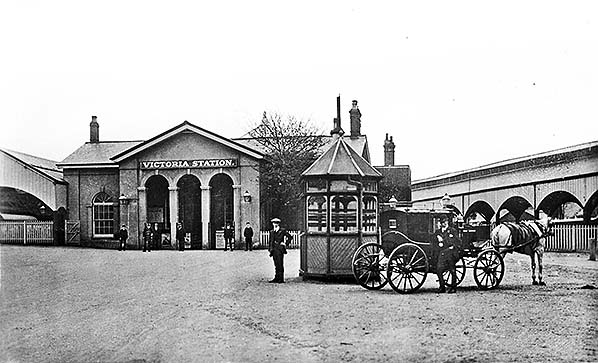 A postcard image, dating from 1910, showing the station forecourt at Norwich Victoria. The tip of the rotunda building housing the booking office can be seen behind the tree. The ‘V’ shape of the two platforms is clearly pictured, one with a full train-shed the other with open sides and its clerestory roof. In the foreground is an elegant octagonal office or shelter presumably used by staff managing the station forecourt and looking after ‘Hansom Cab’ traffic.
Copyright photo from John Alsop collection and from Eastern Daily Press Library, reference c11007  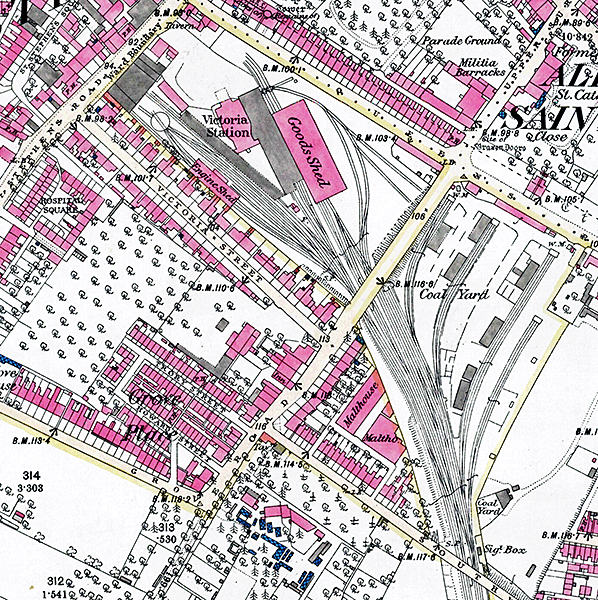
1996 1:2,500 OS map. The station is shown in its completed state, with covered platforms, engine and goods sheds and the nearby extensive coal yard all in place. There are wagon turntables shown going off each of the two goods shed roads. The small building at the convergence of the two platforms is a water tank. Click here for a larger version
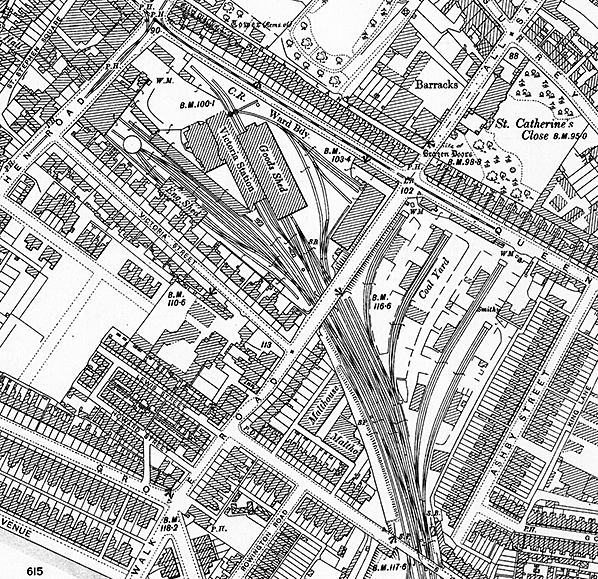
1907 1:2,500 OS map. Surveyors for the Edwardian era map detected little or no material change in and around Victoria station from the 1886 map. One of the sidings north of the goods shed has been lengthened and the crossover south of the engine shed has been removed.
Click here for a larger version 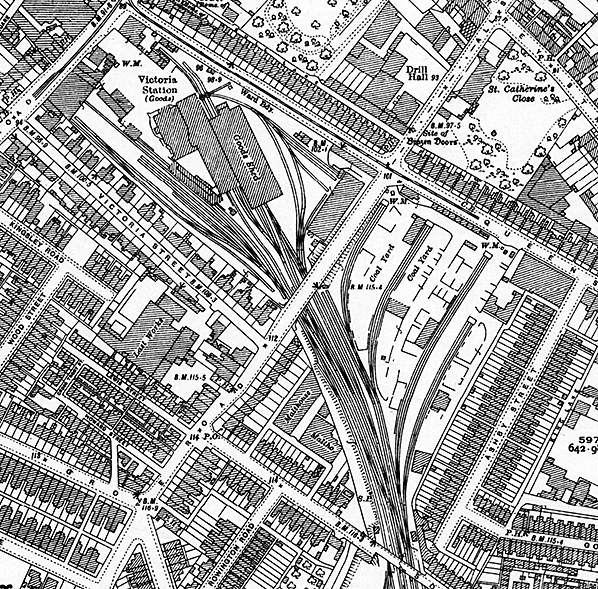
1928 1:2,500 OS map. When the map was reviewed in the mid-1920s Victoria station had been closed to passenger traffic for 10 years. It is now correctly identified it as ‘Victoria Station (Goods)’. The engine shed and turntable had gone and the loop lines that by-passed the shed were reduced to sidings. At least part of the covering on the south-western platform was missing.
Click here for a larger version 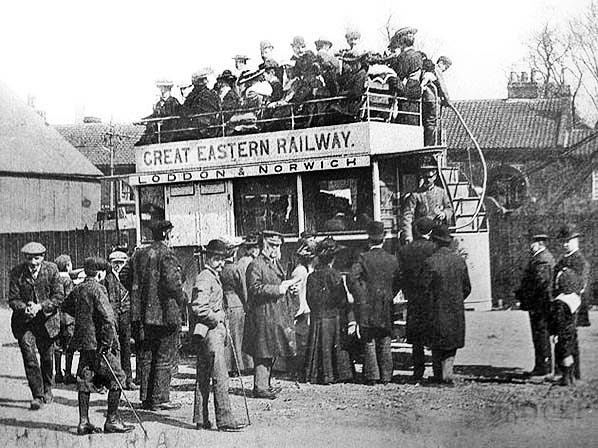
A well-loaded motor bus of the Great Eastern Railway (GER) stands on the forecourt of Norwich Victoria station. The presence of what appears to be the stationmaster along with a number of bowler-hatted gentlemen might suggest the inauguration of the bus service. As the route board shows, this bus was operating between Loddon and Norwich. The route was Beccles - Loddon - Norwich but operated in two sections; Loddon - Norwich and Loddon - Beccles. The Norwich section had begun operations earlier in 1905 but terminated at Trowse, being extended to Victoria on 9 October and thus the earliest possible date for this photograph. Upon closure of Norwich Victoria to passengers on 22 May 1916, the Loddon buses were diverted to Thorpe so this will be the latest date for the photograph. Click here for a much more detailed caption.
Photo copyright Eastern Daily Press Library 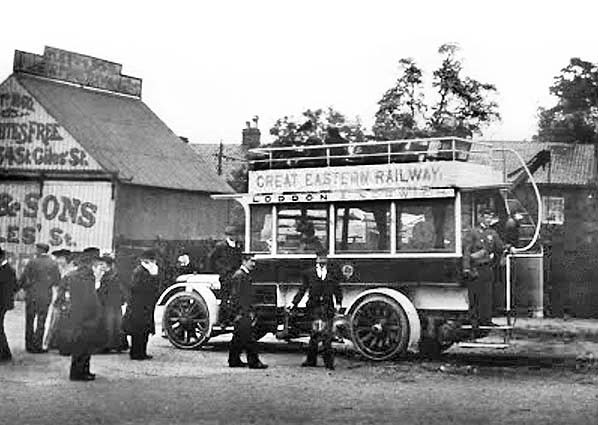
A GER motor bus stands at Norwich Victoria sometime between 1905 and 1919 on the service from Loddon. The actual location is on the north-east side of the station forecourt, with the station itself to the right. This service and the GER buses are described briefly elsewhere so it is not necessary to go into too much detail here. It is nevertheless worth adding that the bus seen here is another of those built at Stratford by the GER but this example is not fitted with a luggage compartment. These Stratford-built buses had 'AN' registrations which at the time signified West Ham. We are here offered a better idea of the bus livery; red and white with GER crest and the name in full on the upper deck decency boards. The rather blatant advertising on the building to the left is for somebody with, presumably, offices on St. Giles' Street, Norwich. Unfortunately searches of Kelly's Directory for this period failed to reveal who it was. In the background behind the staircase of the bus can be seen the yard's 5 ton crane. The crane stood alongside a siding serving a dock. The houses in the far background are those of Queen’s Road and just ahead of the top deck of the bus can be seen a tramway traction pole and bracket. Two tram routes served Queens Road; Orford Place - Trowse Station and Orford Place - City Road/Lindley Street. A third route, that to Newmarket Road, also served Victoria but ran via St. Stephen's Road out of view to the left. Norwich Electric Tramways found itself in the ownership of the Eastern Counties Omnibus Co. Ltd., which had been formed in 1931, and who progressively replaced the trams with buses. The last tram on the Norwich system, which was of 3ft 6in gauge, ran in 1935. What is thought to have been the last surviving traction pole, on Earlham Road, and which had been used to support a street lamp, was removed, supposedly due to concerns about corrosion, in September 2017.
Photo from James Lake collection 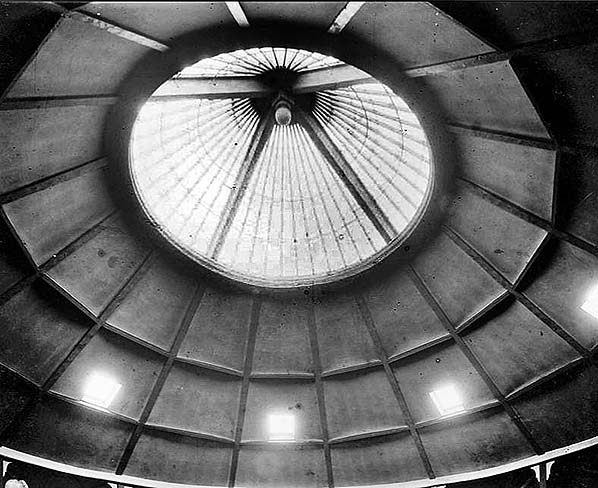
The rotunda roof at Norwich Victoria station probably pre-dated the railway’s coming and was part of the circus building that occupied the site until the 1840s. The area was used as the station’s booking office and this was how it looked in 1913, three years before the station closed to passengers.
Photo from John Mann collection 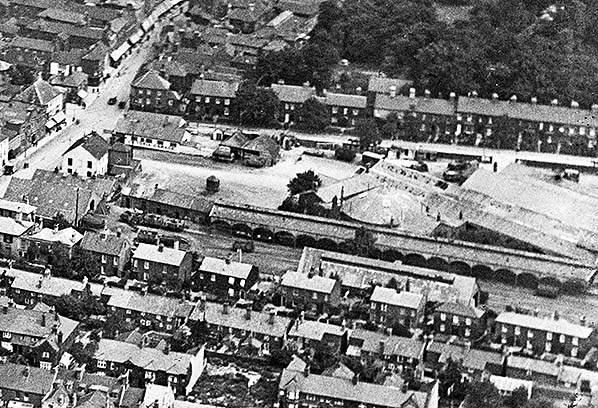 Norwich Victoria station in 1920. Although by this date the station only handled goods traffic little appears to have changed. The two covered platforms are clearly seen forming a triangle with the entrance building. The dome over the booking office is seen in the centre of the triangle. To the west of the station the two-road engine shed is seen with a turntable at its north end. This is the only known photo of the shed. The date of closure of the shed is uncertain; this photo shows a loco on the turntable and what may be coal wagons at the other end so it appears that the shed was still in use in 1920. The building to the east of the station (right on this photo) is the goods shed; a number of goods vehicles are seen in the yard. The small circular kiosk on the station forecourt is for staff handling can traffic and is visible in the 1910 photo. Click here for a larger version.
Copyright photo from Britain From Above, reproduced with permission 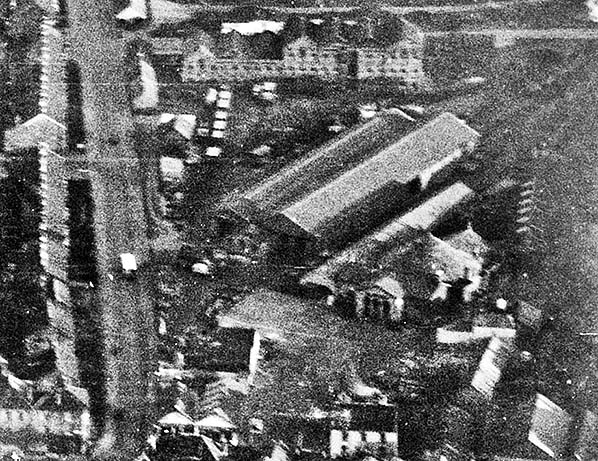
Norwich Victoria station in 1936. Although the quality of this image is poor the main features of the station can still be made out. The station entrance building is seen with the rotunda housing the booking office to its rear. The covering over one of the platforms is still in place while that over the second platform has been partially demolished. The large goods shed is seen to the west (left)
of the station. Copyright photo from Britain From Above, reproduced with permission
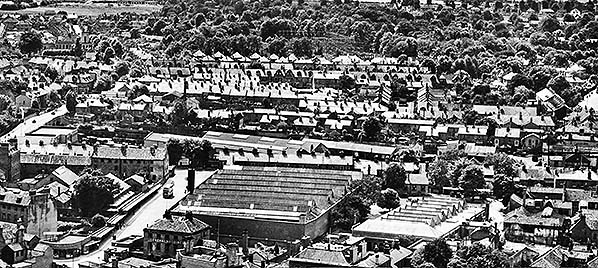
Norwich Victoria goods station looking south-west in 1946. Although much of the station site is obscured by other buildings some parts of the station can be seen. The three arch Grove Road bridge is seen on the left. A number of trucks are seen in the siding that runs to the north of the goods shed. The good shed is seen and parallel with it to the south the trainshed which is still in place over one of the passenger platforms. The entrance building can be seen behind the trainshed but the domed rotunda that housed the booking office has gone. The station forecourt is largely obscured but on the far right a coal merchant's office is seen The name R Coller & Sons is seen on the buildings; a couple of coal lorries are seen alongside. Click here for a larger version.
Copyright photo from Britain From Above, reproduced with permission 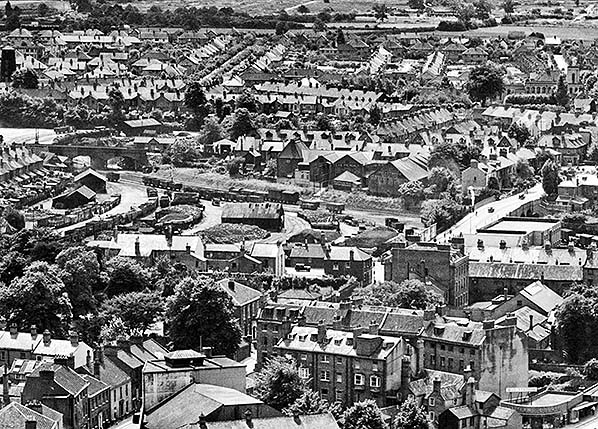 Norwich Victoria coal yard looking south-west in 1946. Grove Road bridge is seen on the left with Southwell Road bridge on the right. Norwich Victoria goods station is out of view to the right. Click here for a larger version.
Copyright photo from Britain From Above, reproduced with permission 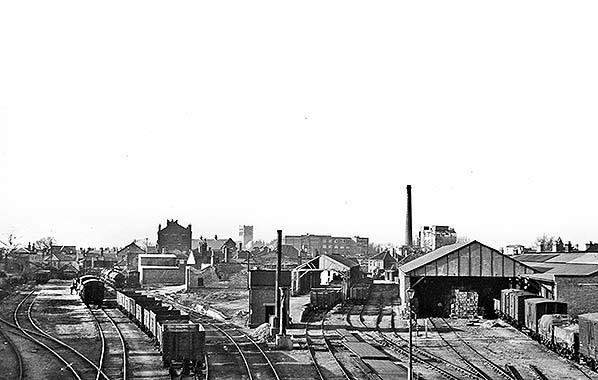
Taken in 1948, Norwich Victoria station, by then 32 years a goods facility, has an air of dereliction about it. That may have been, at least partially, the result of the devastating air-raids on the city that happened from 27 to 30 April 1942. The train shed is intact as is the original goods shed. The covering on the other platform has gone as has the locomotive shed which would have been on the extreme left of the image; the shed roads are now sidings. A water tank is seen at the end of the two platforms. The chimney in the background may be part of A J Caley & Son Ltd.’s chocolate factory (Fleur-de-Lys works) in St. Stephen Back Street. The church tower is that of St. John the Baptist Catholic Cathedral.
Copyright photo from John Alsop collection
Click here for Norwich Victoria Station Gallery 2:
| |||||||||||||||||||||||||||||||||||||||||||||||||||

 It appears that the relationship between one of the ECR’s senior engineers, Peter Bruff and the chief engineer John Braithwaite, was hostile. Braithwaite’s grand plan included expensive viaducts and earthmoving. The cause of friction was Bruff’s assertion that the line could be completed onwards to Ipswich for much less than Braithwaite’s estimated £800,000. Bruff was dismissed from the company in 1842 but he kept in touch with company director John Chevallier Cobbold, who was a prominent Ipswich business-man and brewer in the town. He proved instrumental in moving forward plans for a railway to Ipswich where residents and businesses were anxious for a connection to the growing railway network. A scheme for the Eastern Union Railway (EUR), to be built far more cheaply than Braithwaite’s project, put to a public meeting on 8 August 1843, was sent to Parliament in 1844. The plan and its Act received Royal Assent on 19 July that year, with capital of £200,000 permitted. With Bruff in charge the line would be engineered for double track but built as a single line. After rethinking that issue the company obtained a separate Act of 21 July 1845 that added £50,000 to the capital so that it could lay double track.
It appears that the relationship between one of the ECR’s senior engineers, Peter Bruff and the chief engineer John Braithwaite, was hostile. Braithwaite’s grand plan included expensive viaducts and earthmoving. The cause of friction was Bruff’s assertion that the line could be completed onwards to Ipswich for much less than Braithwaite’s estimated £800,000. Bruff was dismissed from the company in 1842 but he kept in touch with company director John Chevallier Cobbold, who was a prominent Ipswich business-man and brewer in the town. He proved instrumental in moving forward plans for a railway to Ipswich where residents and businesses were anxious for a connection to the growing railway network. A scheme for the Eastern Union Railway (EUR), to be built far more cheaply than Braithwaite’s project, put to a public meeting on 8 August 1843, was sent to Parliament in 1844. The plan and its Act received Royal Assent on 19 July that year, with capital of £200,000 permitted. With Bruff in charge the line would be engineered for double track but built as a single line. After rethinking that issue the company obtained a separate Act of 21 July 1845 that added £50,000 to the capital so that it could lay double track.  By now Norwich was the focus of attention for promoters of many railway projects, several of which went before Parliament in its 1846 session. It was the I&BR’s scheme that obtained Royal Assent, doing so on 27 July 1846. Its route would leave the Bury line at Haughley and pass through Diss on its way to Norwich. Its Act permitted merger with the EUR and shareholders of both companies soon agreed to that plan, with an expectation of practical effect from the start of 1847. Difficulties in merging the capital funds of the two entities was experienced and required a new Act, of 9 July 1847, before they could be overcome. After more delay the railway commissioners gave their consent in February 1848. However, by that time ‘railway mania’ had waned, the economy was in recession and money was hard to come by. Thus progress towards Norwich was slowed, not helped by more problems encountered with boggy land. Nevertheless Diss was reached by contractors on 19 January 1849. Progress was faster after that and the company’s directors boarded an inspection train to Norwich on 3 November, followed by a celebratory special on the seventh. Goods traffic to and from the railway’s Victoria terminus started on 3 December and passengers were allowed to travel nine days later from 12 December 1849.
By now Norwich was the focus of attention for promoters of many railway projects, several of which went before Parliament in its 1846 session. It was the I&BR’s scheme that obtained Royal Assent, doing so on 27 July 1846. Its route would leave the Bury line at Haughley and pass through Diss on its way to Norwich. Its Act permitted merger with the EUR and shareholders of both companies soon agreed to that plan, with an expectation of practical effect from the start of 1847. Difficulties in merging the capital funds of the two entities was experienced and required a new Act, of 9 July 1847, before they could be overcome. After more delay the railway commissioners gave their consent in February 1848. However, by that time ‘railway mania’ had waned, the economy was in recession and money was hard to come by. Thus progress towards Norwich was slowed, not helped by more problems encountered with boggy land. Nevertheless Diss was reached by contractors on 19 January 1849. Progress was faster after that and the company’s directors boarded an inspection train to Norwich on 3 November, followed by a celebratory special on the seventh. Goods traffic to and from the railway’s Victoria terminus started on 3 December and passengers were allowed to travel nine days later from 12 December 1849. 
 Home Page
Home Page